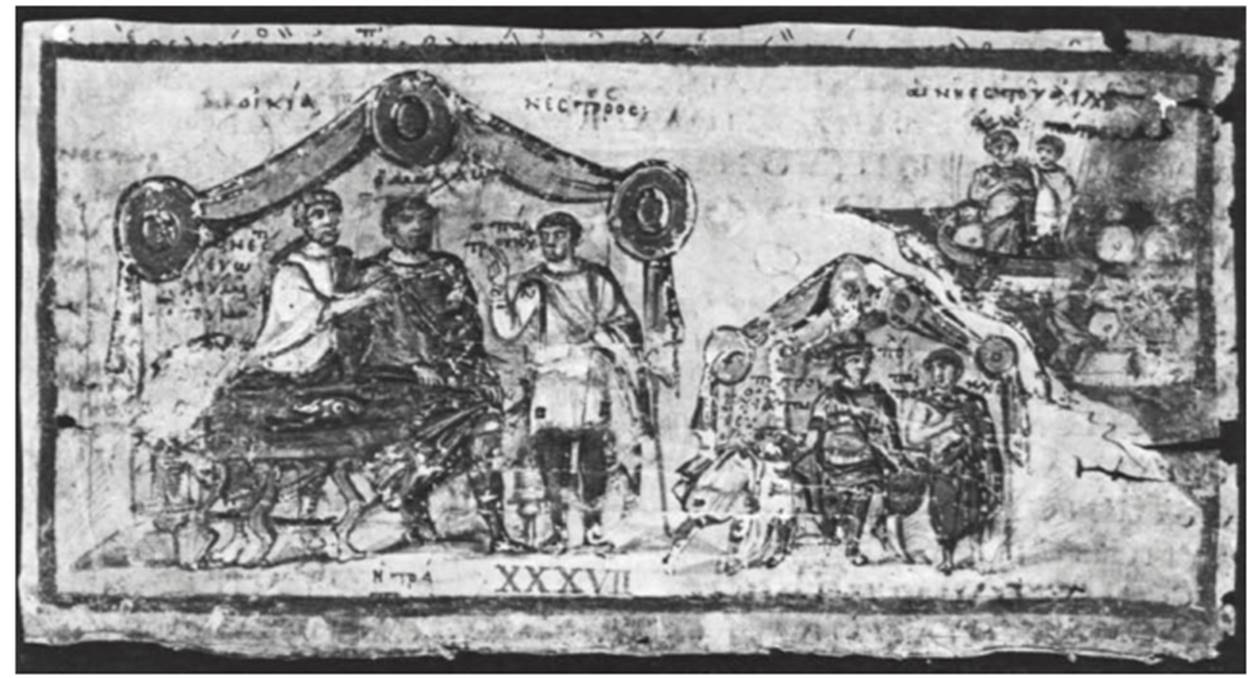The Ambrosian Iliad. Alexandria (?), 2nd half 5th century. Parchment
In its original form this Iliad was a parchment codex containing the complete text of Homer's poem, written in a fine majuscule script and embellished with as many as 200 illustrations. During the medieval period, the illustrations were cut from the codex; only fifty-two are preserved. Even in its present condition the Ambrosian Iliad is the most important illustrated Greek literary text to have survived from antiquity. On the evidence of both figure style (Weitzmann [1], 1954, pp. 260- 263) and script (Cavallo, 1973, pp. 81-85), it has been attributed to an Alexandrian scriptorium of the second half of the fifth century. The pictures depend on a long tradition of Iliad illustrations, some going back to the narrative cycles of papyrus rolls (cf. nos. 194, 205, 222). When the parchment codex gained popularity, such simple pictures were expanded into larger framed paintings, with new possibilities for the use of color and space. The following miniatures demonstrate some of the picture types.

Miniatures XX and XXI (Book 5). Two battle scenes have been enclosed within the same frame. The only clue as to which events are shown is the figure of the wounded Sarpedon reclining under an oak tree in the lower scene (verses 684-698). The various groupings of Trojans and Greeks are probably descended from models in earlier narrative cycles in papyrus. Above the battle hover Athena, Zeus, and Hera. In the upper scene a Greek stands out; he must be Menelaos striding “out among the champions helmed in bright bronze, shaking his spear" (562-563). The muted colors—orange, blue, green, purple—are characteristic and recur somewhat monotonously in the other miniatures. These chaotic, almost textured battle scenes have been compared to earlier Roman reliefs, including battle sarcophagi (Bianchi Ban- dinelli, 1955, pp. 125-128).
Miniature XXXIV (Book 10. 372-464). Two scenes are incorporated within the same frame. At the left Odysseus and Diomedes have seized the Trojan spy Dolon, who wears a wolf-skin disguise; at the right, Dolon is killed. Behind the figures are pale bands of lavender and blue, and above hovers the personification of Night. The emphasis here is on the action. The two scenes are probably derived from older models in the “papyrus style." They are not faithful to the text in details, as, for example, the dismemberment of Dolon, who is merely decapitated in Homer. The stiff, rather dramatic poses are typical. A preparatory drawing for Odysseus in the second scene can be seen just to the right of the painted figure.
Miniature XXXVII (Book 11). Three scenes are here combined. In the first, Achilles stands in the stern of his ship, watching the battle, which turns against the Greeks (598-615). With him is Patro- clus, whom he sends to the tent of Nestor. In the second scene, Patroclus stands in the entrance of the tent conversing with Nestor, who sits beside the wounded Machaon (643-802). In the third scene, on a smaller scale, Patroclus treats the wounded Eurypylus, while to the right stands a third figure (wrongly inscribed "Patroclos" by the medieval commentator). In the two lower scenes a larger seated figure is flanked by two others, mostly on a smaller scale; such compositions are often in use in later Roman art for royal or imperial subjects (cf. no. 64).
Miniature XLVII (Book 16. 220-252). Achilles pours a libation to Zeus, praying for the glory of Patroclus' mission and for his safe return. He is depicted in the guise of a Roman magistrate, or even an emperor; barefoot, he wears the toga pulled up over his head and stands before an altar. The sacrificing Achilles is known earlier (Bianchi Bandinelli, 1955, fig. 153); here the flattened, angular figure has been considered typical of Alexandrian figure style in the Late Antique period (Weitzmann [1], 1954, pp. 261-263).
The Ambrosian Iliad was evidently in Constantinople in the later Middle Ages, when the inscriptions identifying the subjects of the miniatures were added (de Wit, 1932). In 1608, Cardinal Federico Borromeo purchased it at Naples for the Ambrosian Library. Bibliography: De Wit, 1932; Calderini, 1953; Weitzmann (1), 1954, pp. 241-264; Bianchi Bandinelli, 1955; Bianchi Bandinelli, 1971, pp. 86-96; Cavallo, 1973.
Date added: 2025-08-31; views: 98;
